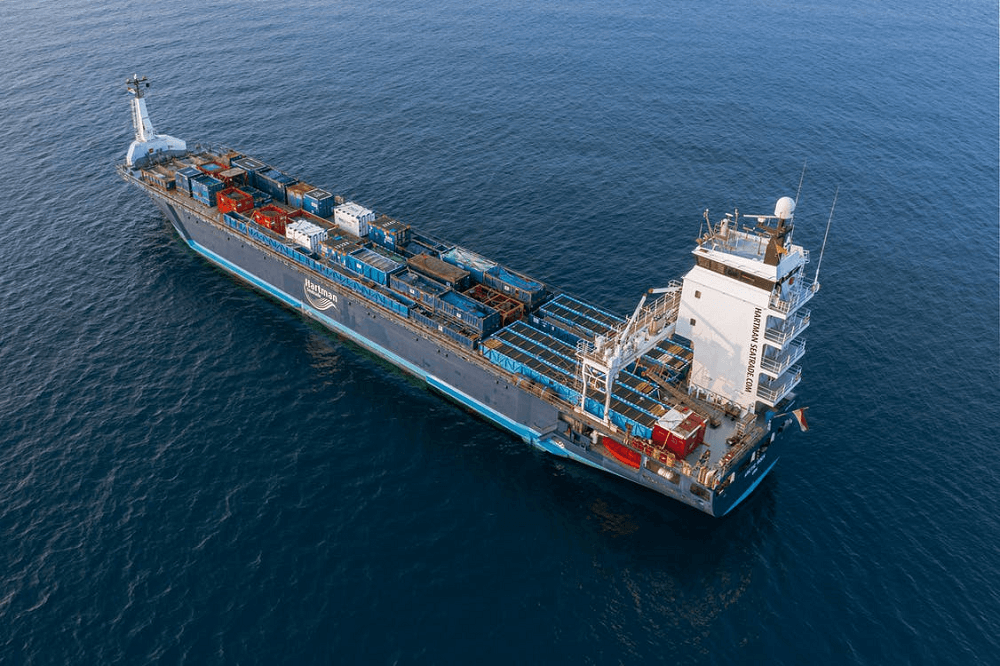
by Sam Franklin | June 18, 2022 | 11 min read
Understanding the Carriage Paid To (CPT) Incoterm
Get fundedLast updated: July 08, 2022
Shipping can be a literal nightmare for newly-born eCommerce retail stores. Although it might seem straightforward, it’s not as simple as calling DHL and asking for a quote.
Instead, the shipping process usually involves multiple carriers with many restrictions depending on the transport mode used. In addition, many different shipping policies place various levels of risk on the buyer.
To make things easier, the International Chamber of Commerce grouped shipping policies into eleven categories called Incoterms. These Incoterms help define the responsibilities between buyers and sellers and outline who bears the risk at specific legs of the journey.
This article will cover the Carriage Paid To (CPT) Incoterm and tell you everything you need to know before shipping under the policy.
If you’re looking for information on the other Incoterms, see our Incoterms Overview section.
Table of content
What is Carriage Paid To (CPT)?

CPT stands for Carriage Paid To and is one of the eleven international Incoterms published by the International Chamber of Commerce in 1936.
CPT specifies that the seller bears the costs for transporting goods to a nominated place at the buyer’s request.
Usually, the seller delivers the goods to a carrier at their expense. The liability of the shipment is transferred once the goods are delivered to the first carrier, typically at the origin port.
The delivery point is not a defined location in this Incoterm and must be negotiated in terms of sale to avoid confusion about who is liable.
Typically, the delivery occurs when the seller gives the goods to the first carrier who is sending the goods to the buyer. This could be at the seller’s warehouse, at a port, or at a cargo terminal. As soon as the seller has delivered the goods to the contracted carrier, the risk transfers from the seller to the buyer.
From then on, the buyer takes the risk of loss or damage to the goods. However, the seller is still obligated to pay the freight costs until it arrives at the agreed destination in the buyer’s country. This is why the Incoterm is called Carriage Paid To because the carriage is paid to the final destination.
The seller is responsible for the export clearance and any other export formalities in the origin country. However, the buyer handles all the duty and import fees once the goods arrive in the destination country.
Understanding Carriage Paid To (CPT)

Carriage Paid To belongs to Incoterm group one and can be used for all modes of transport, such as sea, air, or rail freight. It can also be used for road and inland waterway transport. CPT is applicable for usage when there is more than one mode of transportation along the entire journey.
Although it is a pretty versatile Incoterm, it is not commonly used as there are always likely to be better individual options.
One of the problems with Carriage Paid To is that there is no defined location in the Incoterm, leading to quite a lot of confusion for buyers and sellers. As a result, both parties must define two points in the shipment; the delivery and destination points.
The point of delivery is where the goods are transferred to the first carrier. For example, the carrier could be a truck at the seller’s warehouse, or the seller could arrange transport to a dock or an air terminal to meet the first carrier. The point of delivery is essential to know as this is where the risk transfer occurs.
The second point both parties have to determine is the destination point. This is where the main carrier ships the goods to the buyer’s country, a responsibility that the seller pays for.
CPT is typically used in conjunction with a destination when a seller quotes it. For example, CPT Liverpool would mean the seller pays freight charges to Liverpool. However, risk transfer still happens as soon as the goods are delivered to the first carrier. This would mean that the seller is not liable for the risk of loss or damage during the main carriage as the goods make their way to Liverpool.
Finally, insurance is not an obligation for either party in CPT. However, it is always recommended to take out sufficient insurance if the loss of goods would impact the business's bottom line.
What do CPT shipping terms include?

The shipping terms for CPT include the time and place for the delivery to occur. It also breaks down the risk transfer between buyer and seller and outlines who is responsible at what leg of the journey.
Following is a list of the standard terms seen in a CPT agreement:
Payment due to seller
Time and place of delivery
The delivered and destination points
Which carrier(s) will be used for the journey
Who is responsible for loading
Which party takes the cost of freight
Which party handles relevant import/export formalities
Seller’s responsibility
In the CPT incoterm, a seller is responsible for:
Delivering goods safely at the agreed date and point
Creating a sales contract and a commercial invoice
Export packaging and marking
Loading cost
Delivery to the carrier at port/place
Cost of contracting the main carriage to the destination place.
Origin and destination terminal handling charges
Pre-shipment inspection
Usual proof of delivery to the carrier
Providing notice to the buyer that goods have been delivered
Export formalities such as duty, taxes, and customs clearance
Buyer’s responsibility
In CPT, a buyer is responsible for:
Paying for the goods as dictated in the contract of sale
Providing seller with relevant information required for obtaining documents and fulfilling obligations
Onward carriage delivery to the final destination
Unloading at destination
Import duty and taxes
Import clearance at the destination terminal
As mentioned, insurance is not an obligation for either party. Still, it is in the buyer’s best interest to ensure that any insurance paid covers the minimum value of the goods for the voyage as the buyer carries the risk on the main carriage.
Where are the risk transfers in the CPT?
Risk transfer occurs when the seller hands the goods to the first carrier on the journey. As CPT can be used for multiple transport modes, the first carrier is likely to be a truck at the seller’s warehouse and doesn’t have to be the seller’s carrier contracted for the main carriage.
However, it is essential to distinguish the point of delivery and destination place in the contract of sale because it dictates where the risk transfer occurs. The point of delivery doesn’t have to be the first carrier if both parties agree to the contract of sale. The delivery point can be earlier or later in the shipping process.
When to use CPT

CPT benefits bigger importers with agents in both the origin and destination countries. These agents can understand the small components of a CPT agreement, such as controlling destination terminal handling charges and customs clearance, and ensure the shipping process runs efficiently.
Additionally, CPT can be used in transport with multiple carriers, so it is excellent for overland transport such as cross-border trade.
When not to use CPT
Typically, CPT should not be used when multiple carriers are involved in moving the cargo as it will not work because it increases the buyer’s separation.
In addition, the buyer holds the risk of loss or damage to the goods as soon as they have been delivered to the first carrier. So, every additional carrier used along the journey increases the buyer's risk.
With this in mind, China Sea Freight is unsuitable for CPT because the cargo is paid for before the shipment leaves the origin country. With China Sea Freight, the cargo could be on the dock waiting to be loaded for days before it is on board the main carriage.
Advantages of CPT
The buyer assumes the least risk when the payment terms indicate that the goods must be paid for at the destination terminal. In this case, CPT can be a useful Incoterm for the buyer but must be explicitly stated in the sales contract. Under these conditions, the buyer would not be obligated to pay for the cargo until it arrives at the agreed-upon destination.
Additionally, the seller must supply a Bill of Lading (or Airway Bill) for the buyer, which limits the buyer’s responsibility for most of the shipping process.
The last advantage for the buyer is that the seller handles export requirements. So, they only need to worry about relevant import formalities.
The Carriage Paid To (CPT) Incoterm can also be advantageous to the seller as they have no obligation to organise an insurance policy. Their risk for loss or damage to the goods ends as soon as they hand them to the first carrier. They are still responsible for the main carriage but have no risk if something happens to the goods along the journey.
Furthermore, the seller has complete control over the transport chain, allowing them to choose the most economical carrier and find the best deal that suits them.
Disadvantages of CPT
Many of the disadvantages of using CPT Incoterms lie with the buyer.
First, the buyer is unaware of who the carrier is unless it’s defined in the purchase contract, which doesn’t always happen. They have to rely on the seller’s carrier to move the shipment to the destination and assist the seller with importing.
If the cargo has to pass through another country along the journey, the buyer is responsible for the relevant transit clearance. This adds further complexity for the buyer, especially considering that they already don’t have any formal relationship with the carrier.
As the risk transfer occurs when the seller delivers the goods to the first carrier, there could be many problems in the journey.
For example, let’s say the first carrier is a truck transferring cargo to the airport. If the truck was in an accident, the seller would not be liable as the goods have already been transferred. This would mean the buyer would have to claim to recoup the value of the goods if they were smart enough to insure their shipment.
Furthermore, the seller is always likely to look for the cheapest transportation option as it is in their best financial interest to keep costs low. Typically, the seller won’t worry about the product's safety as their risk is transferred away from them as soon as the first carrier receives the goods.
Lastly, terminal handling charges and freight costs are likely to be included in the price, meaning the buyer will always be paying higher prices for the goods than if they were to arrange the shipping themselves.
The only disadvantage to the seller is that they must organise and pay for main carriage shipping and factor this into the total cost.
CPT vs other Incoterms

Below is a quick comparison and summary of CPT against other popular Incoterms.
CIF vs CPT
CIF stands for Cost, Insurance, and Freight. Both of these C-Incoterms might look similar but are very different in practice. CIF is only viable on sea and inland waterway shipments, whereas CPT can be used for all modes.
In CIF, the seller is also required to deliver cargo to the destination port, and the risk transfer occurs when the goods have been loaded on the vessel scheduled for the main carriage - much later than the risk transfer in CPT.
Lastly, insurance is also an obligation under CIF and is not required in CPT.
DDP vs CPT
DDP stands for Delivered Duty Paid. DDP places the entire responsibility on the seller compared with CPT.
Under DDP, the seller must deliver the goods to an agreed-upon destination, usually the buyer’s warehouse.
The risk transfer occurs later in DDP when the goods are made available to the buyer at the final destination. DDP also requires the seller to handle all import duties and import fees.
Conclusion
Carriage Paid To is a versatile Incoterm for buyers as the entire main carriage is handled by the seller. The seller bears the cumbersome export formalities, so the buyer just has to receive the goods and load them onto their trucks for onward carriage.
However, there are certain disadvantages to the buyer that must be carefully considered before using this Incoterm in a shipping policy.
Written by

Sam founded his first startup back in 2010 and has since been building startups in the Content Marketing, SEO, eCommerce and SaaS verticals. Sam is a generalist with deep knowledge of lead generation and scaling acquisition and sales.


